EE THr
Silver Member
Speaking of labyrinths and logic---
It seems to be that if someone were going to carve something very important on rock, they wouldn't just carve through existing lichen. I'm thinking they would use a flat rock or something, and rub off any existing lichen before they began carving. Especially if the carving was going to be intricate, like this one is.
Also, at first glance, it looks like the lichen grew all at the same time, because the patterns progress across the lines perpendicularly, rather than having separate patterns along the inside of the lines. And at some places, there seems to be as much, or more, growth inside the lines as there is beside them, because there is no shadow in those parts of the lines. But that's just my totally un-expert observation and opinion.
This is not a spiral. It is a labyrinth. And not just any maze-like design, it's The Classical Labyrinth. I think those are huge and important differences.
The King Minos Labyrinth was actually a maze (because it had many possible routes, while a labyrinth has only one route, and so it is easy to get into and out of), even though it was named "Labyrinth" back in it's day. (Just to distinguish the difference, I'm using the modern terminology for the two concepts.) Somehiker's labyrinth is a true labyrinth, by modern terminology, because all you have to do to walk it is follow your nose. You can't get lost.
Obviousely, it would be difficult to draw an exact duplicate of the King's "Labyrinth" maze, so when it was depicted, they used a simplified symbol to represent it---at some point this symbol became that which is currently referred to as The Classical Labyrinth. I think it's likely that very few people knew the actual layout of the King's "Labyrinth," anyway, so that would be another reason to symbolize it.
Additional clues to possible symbolic meanings are as follows---
Origin:
1540–50; < L labyrinthus < Gk labýrinthos; r. earlier laborynt < ML laborintus, L, as above
-----
Word Origin & History
labyrinth
Late 14c., from L. labyrinthus , from Gk. labyrinthos "maze, large building with intricate passages," especially the structure built to hold the Minotaur, from a pre-Gk. language; perhaps related to Lydian labrys "double-edged axe," symbol of royal power, which fits with the theory that the labyrinth was originally the royal Minoan palace on Crete and meant "palace of the double-axe." Used in English for "maze" early 15c., and in figurative sense of "confusing state of affairs" (1540s). Related: Labyrinthine .
-----
http://dictionary.reference.com/browse/labyrinth
-----

It seems to be that if someone were going to carve something very important on rock, they wouldn't just carve through existing lichen. I'm thinking they would use a flat rock or something, and rub off any existing lichen before they began carving. Especially if the carving was going to be intricate, like this one is.
Also, at first glance, it looks like the lichen grew all at the same time, because the patterns progress across the lines perpendicularly, rather than having separate patterns along the inside of the lines. And at some places, there seems to be as much, or more, growth inside the lines as there is beside them, because there is no shadow in those parts of the lines. But that's just my totally un-expert observation and opinion.
This is not a spiral. It is a labyrinth. And not just any maze-like design, it's The Classical Labyrinth. I think those are huge and important differences.
The King Minos Labyrinth was actually a maze (because it had many possible routes, while a labyrinth has only one route, and so it is easy to get into and out of), even though it was named "Labyrinth" back in it's day. (Just to distinguish the difference, I'm using the modern terminology for the two concepts.) Somehiker's labyrinth is a true labyrinth, by modern terminology, because all you have to do to walk it is follow your nose. You can't get lost.
Obviousely, it would be difficult to draw an exact duplicate of the King's "Labyrinth" maze, so when it was depicted, they used a simplified symbol to represent it---at some point this symbol became that which is currently referred to as The Classical Labyrinth. I think it's likely that very few people knew the actual layout of the King's "Labyrinth," anyway, so that would be another reason to symbolize it.
Additional clues to possible symbolic meanings are as follows---
Origin:
1540–50; < L labyrinthus < Gk labýrinthos; r. earlier laborynt < ML laborintus, L, as above
-----
Word Origin & History
labyrinth
Late 14c., from L. labyrinthus , from Gk. labyrinthos "maze, large building with intricate passages," especially the structure built to hold the Minotaur, from a pre-Gk. language; perhaps related to Lydian labrys "double-edged axe," symbol of royal power, which fits with the theory that the labyrinth was originally the royal Minoan palace on Crete and meant "palace of the double-axe." Used in English for "maze" early 15c., and in figurative sense of "confusing state of affairs" (1540s). Related: Labyrinthine .
-----
http://dictionary.reference.com/browse/labyrinth
-----






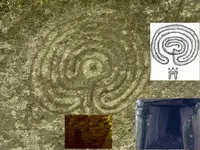
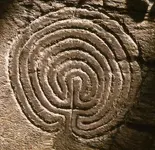
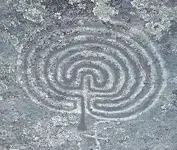
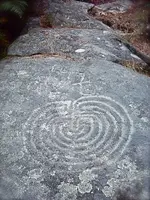

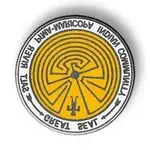
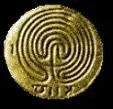


 Find the other opinions valid and all interesting.
Find the other opinions valid and all interesting.
